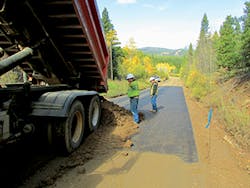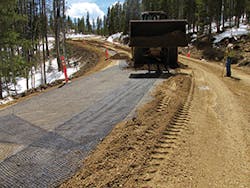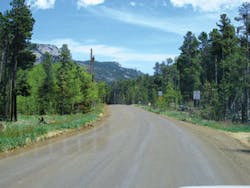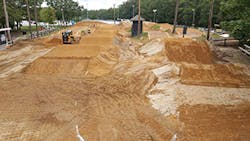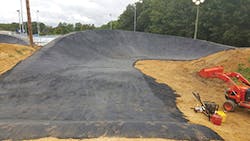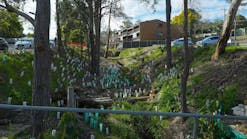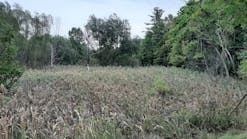Dust Control for Safety—and Cost Savings
Air quality is essential for the environment and for the people and animals who breathe that air. A big part of ensuring that the air is of high quality is keeping it free of dust.
Controlling dust—preventing it from escaping its source—is not as easy as it sounds. That is particularly true when continual disruption of the ground or other surfaces is taking place because of construction, recycling, vehicles traveling down an unpaved road, or even kids racing bikes on dirt tracks.
As the following case studies show, controlling dust can be challenging. Fortunately, there are different methods to use and a variety of products that are very effective.
Repairing boggy areas on Gilpin County roads.
Snow Country: Gilpin County
It’s not the highest “Rocky Mountain High,” but Gilpin County, CO, (average elevation 9,000 feet) has that High Country feeling and scenery. The mostly rural county is situated about an hour west of Denver, between the foothills of the Rockies and their highest points.
Gilpin County gets plenty of snow for winter sports. Elk and moose are common sights. The summer season brings visitors to enjoy the state park nearby.
Keeping Gilpin County’s 150 miles of roads in good shape is public works operations supervisor Gordon Thompson’s responsibility. He’s been on the job there since 1998. Thompson and his crew rely on two products from EnviroTech Services of Greeley, CO.
“On 90% of our roads we use a straight magnesium chloride, RoadSaver. We use durablend [an enhanced polymer blend] in high-travel areas, on steep hills such as Dory Hill Road. The mag [RoadSaver] works on it well, but durablend lasts forever,” says Thompson.
Repairing boggy areas on Gilpin County roads.”On Dory Hill Road, a storm came in when we had no more than gotten the durablend applied. It was a real gully washer! I was sure it would be washed out.”
But when Thompson drove over to check the road early the next morning, “It was fine! It was really impressive the way that hill had held together.”
Thompson says that for many years in the past, Gilpin County had used a lignosulfate magnesium blend, but it became hard to get and its price went up. “In 2010 we went back to using durablend.”
He adds, “durablend is thick, so a light spray of water right behind the application helps it spread. It’s a little higher priced than RoadSaver. It’s a topical application that doesn’t penetrate the road surface as much as the mag, which has to be down one and a half to two inches.”
Thompson recalls that when the Gilpin County road crews started using magnesium chloride on the roads, some citizens expressed concern about runoff. The crew followed recommendations, but some of the substance ran off of the roadsides. Changing the way the product is applied eliminated that issue. “We apply half of the application rate, let it cure, then add more. We leave some loose material at the edges of the road to absorb any excess.”
Gilpin County’s road crew has “a small window of time to work in. We can’t start until the second week of May. We can work only through September, maybe into October, before we get snow,” explains Thompson.
Weather is the major factor in his department’s work and operating schedule. “We have huge downpours that are pretty destructive, and once snow begins, we go from snow to ice and back again frequently.”
He makes sure that Gilpin County’s two main arteries get done before Memorial Day. “One of them, Gap Road, runs into a state park that attracts a lot of holiday traffic.”
The main roads are treated before winter sets in with a second application of either RoadSaver or durablend. Thompson says that doing this second application on the roads with the most traffic is cost effective. “It helps them hold up a lot better through winter.”
The end of winter and the spring thaws bring a special problem for the road crew. Gilpin County has underground springs flowing beneath the roads. These springs “pop up in our roadways in the spring, creating bogs. Sometimes they only make the road spongy, but most times they get like quicksand,” he says.
To make the roads safe for travel again, the road crewmembers “normally firm them up with four inches of rock, and then cover them with geogrid and cap with road base,” he adds.
Rising High
Lakeshore Recycling Systems serves the Chicago area with five facilities. They include the Heartland Recycling Center and four material recovery facilities: West Chicago, Northbrook, California, and Exchange.
The company’s employees make controlling dust at its operations a priority. They rely on DustBoss cannon machines made by Dust Control Technologies of Peoria, IL. The machines, mounted on three-wheel carriages, are available in four models. The DB-30 shoots a water mist up to 100 feet away. The DB-45 reaches 150 feet; the DB-60 reaches 200 feet; and the DB-100 shoots as far as 328 feet.
“We use DustBoss-30s at most of the facilities,” says Mark Sredin, manager of the California Material Recovery Facility.
The DB-30 disperses water at a rate of 1.4 to 2.8 gallons per minute. Like the other, larger DustBoss cannons, it can also be mounted on a tower.
“California is our first facility. Originally the DustBoss was on a three-wheel frame [on the floor]. It didn’t get [the misted water] everywhere we needed it, to so we mounted it on a pedestal so the water could reach farther. Now the water has more time to disperse,” he explains.
The DustBoss is “six to eight feet off of the working platform. It’s closer to the production so the [crew] guys never get wet.”
The same elevating strategy was used at the Northbrook and Heartland facilities. The ceiling at the Exchange facility is lower, and the winds at this location are strong and change direction frequently, so the DustBoss stays on the ground to make it easy for workers to change its direction.
Gap Road immediately after application of RoadSaver
“West Chicago is our newest facility, acquired from another company. They had a couple of other dust suppression machines. Eventually they’ll be replaced with a DustBoss,” says Sredin.
The DustBoss at the California facility “has an odor injection feature on it,” explains Sredin. “It’s connected to a remote tank with a pump. You can flip a switch and inject [odor suppression material from the tank] into the stream of water.”
Sredin has found the DustBoss dust suppression machines to be “pretty trouble free. The one at California is probably six years old and still going strong. The other machines are more recent. We have two that are three years old and one that is two years old.”
Changing the angle or direction of the dispersed water is easy. “It takes three seconds. If you have a change in the wind, there is a 360-degree pivot [control]. You can make it flow in any direction you want. An oscillation feature allows the flow to move left to right.”
Sredin is not a fan of spray bar dust suppressing machines. “They use a lot of water, and that is expensive,” he notes. “They don’t do the job well because the water droplets are too large. They create pools on the floor that are a slippery hazard for employees.”
Because of local air-quality regulations, he says, “we have to do air sampling once a year. We’ve always been under the required limits. The DustBoss definitely makes a great deal of difference.”
He adds, “We have food manufacturers next to two of our facilities. We want to be on our best behavior and not cause problems for our neighbors.”
Sredin thinks so well of the DustBoss machine that he has recommended it to other people who have to deal with dust. “I tell them, ‘Dust is always going to be there. This is the most effective way to deal with it.'”
He adds, “The DustBoss atomizes water so that it drags dust to the ground. It is definitely the most effective dust control machine.”
McCullough County
Brothers Mack and Morris Hickman own and operate Pennz Road Technologies in Austin, TX. They do a lot of road construction and repair jobs, which include soil stabilization and dust control applications.
One recent project was a 4.5-mile mining road in McCullough County, TX, about two hours from Austin. The client for the public road was McCullough County.
“It was three days of work in April 2016,” says Mack Hickman. “We used a water truck with two guys.”
The product Hickman chose for dust control and soil stabilization was PennzSuppress D. It is an emulsified resin product developed by Pennzoil and sold, since 2011, by PennzSuppress of Grand Prairie, TX. Approved by the California Water Board, it is safe for use near animals and plants.
There was a lot of traffic on this sand mining road, but traffic didn’t have to be stopped while the Hickmans’ crew was doing the work.
“They can drive on top of it while it’s still wet. One time a big 18 wheeler was coming along right behind our water truck,” he recalls.
“It’s the best thing we’ve ever used,” declares Hickman. “We put the product into the water that’s already in the water truck’s tank. It generally goes in at six gallons of water to one gallon of PennzSuppress D.”
He says that the ratio varies by how hard a road’s surface is. He has also used the product for stabilization, mixing it in with 3 inches of crushed limestone.
“When you see dust, you know there’s erosion,” he says.
Hickman also uses the product on gravel roads. “Our experience has been that the common way to maintain gravel roads, today, is to spray water on them. With gravel you are constantly watering and grading because you have potholes forming. That’s very expensive and dangerous and causing dust.”
When using PennzSuppress D, he says, “you don’t have to use a grader or water trucks. You just maintain the road every three to six months, spraying the road with a 30-to-one water-to-product mixture to dress it down.”
Maintaining a gravel road by applying PennzSuppress D initially and then following up with the diluted mixture to reinforce that initial application is much cheaper, Hickman says, because “you’re not losing what you’ve already put down. It won’t wash off. If the road is built correctly, it will drain and it won’t develop potholes. However, if a pothole develops, it’s easy to fix. You just mix some limestone with a little more of the product. You don’t need to grade it. You let the product do the work.”
Hickman says that PennzSuppress D can also be used as a tackifier for hydroseeding in hilly terrain. “Texas A&M’s TTI [Texas Transportation Institute] sprayed it on the side of a hill and then sprayed rye grass.” While the study was going on, “six inches of rain fell over the course of a month and no seed washed away. They got some of the highest- and fastest-growing grass because the product has nitrogen in it,” he explains.
Hickman says that PennzSuppress D is “what every state should be using. We’ve done hydroseeding at landfills and sprayed grass on top. Green mesh is ugly, expensive, and cumbersome to put down.”
By spraying the PennzSuppress D instead of using an erosion control blanket with the grass seed, “you don’t have compression, but you don’t want it because you want the grass to grow,” he says. “The product will hold the grass seed on the hill and help its growth because it has nitrogen.”
Another Texas Transportation Institute study on PennzSuppress D found that even after 7,000 vehicle passes, there was an 86% reduction in dust levels.
Remodeling the track
Racing in Egg Harbor
BMX is the fast-action sport of bike racing on a dirt track. Competitors in BMX range from professional Olympians to children and include adults who race just for fun.
One of the oldest BMX tracks on the East Coast is in Egg Harbor Township, NJ, about 10 miles from Atlantic City. Egg Harbor Township—2010 population about 43,000—is a family-oriented community, and the BMX track draws many children and their families.
“We have riders as young as three. The Striders—between two and three years old—are too little to pedal. They sit on the bikes and push with their feet,” says Dave Dorofee, manager of the BMX track.
At the other end of the age scale is a man Dorofee knows “who is 88 and still racing.”
After Soiltac application
With so many young riders, safety is a constant concern, so maintaining a smooth riding track without ruts is essential. And especially because these young riders are closer to the ground than adults, controlling dust is also important.
The BMX track is owned by the township and open to the public year round. Now, in his seventh season as manager, Dorofee says many other BMX tracks are private and open only for scheduled events.
In Egg Harbor Township, kids can drop by any time to practice or can borrow bikes and helmets to learn how to race safely. The BMX track is a community operation, dependent on volunteers. Many families have been involved with BMX racing for years.
The track was remodeled in 2016 by Tom Ritzenthaler. His firm EliteTrax specializes in designing and constructing BMX tracks. Now the Egg Harbor Township track measures 1,140 feet and contains three turns that are each about 100 feet long. The turns are paved in asphalt because they are the most difficult sections to keep in good condition.
Weather has been a major factor in how much work is necessary to maintain the track. Dorofee says that in past years “heavy rains just killed us, producing ruts in the track’s surface where the bike wheels crossed at an angle.”
Repairing the track to maintain its hard and smooth surface was time consuming. “We had to sort of rip off the track [and rebuild it]. One year we had to do this six times. That’s a huge undertaking and amount of work, especially for a crew of all volunteers.”
Fortunately those days are past. Rainstorms don’t cause stress for Dorofee anymore. In 2015, he and his volunteers began using a different method to keep the BMX track in good condition. They now use Soiltac, a polymer dust control and soil stabilizer made by Soilworks of Scottsdale, AZ.
“It far surpassed my expectations. We all felt like we should have been using it all along. Now I can’t see maintaining the track without using the Soiltac,” says Dorofee. He tells managers of other BMX tracks about the product. “You don’t have to worry about the weather. It can rain in the morning, we sweep off the puddles, and we’re ready to race in the afternoon. Soiltac saves on costs.”
In the past, Dorofee and the crew sometimes had to buy dirt to put on the track and rent machinery because they didn’t have heavy equipment of their own.
Now, Dorofee has rigged up the equipment he and the crew need to apply the Soiltac. He bought a 125-gallon plastic tank and put it on a trailer.
“We use liquid Soiltac. We add it to water in the tank and spray it on with a garden hose. The water brings the Soiltac to the dirt and it goes through into the soil a bit,” he says.
The crew uses a compactor that “shears the dirt together,” he says. “Soiltac is not really made for a BMX track because it’s supposed to permeate the soil about three inches. But on the track, it forms a skin over the top of the dirt. It’s a hard coating.”
He was unsure at first how often he’d need to apply it. He and his crew of volunteers apply the Soiltac in the spring and then one more time before the racing season ends in November. “It would probably last longer if it weren’t on a BMX track with such heavy use,” he says.
“I was surprised at how well it works. It costs us $1,500 to do the track for the year. The people who come out to help don’t have to work so hard or so long. We can all enjoy the facility more,” says Dorofee.
“The riders love it. When they show up, the track surface is the same as when they left it,” he notes.
The water bill for maintenance is also much lower. Even the people working the concession stand are happier because they are not bothered by dust drifting over from the racing bikes’ wheels.
Controlling dust on a job site during work and afterward can be challenging. Weather and other variables often make the work more difficult. But looking for reliable products, asking for recommendations by other users, and choosing the best product for a particular location—even if it’s not the least expensive one available—can go a long way to control dust and saving money.

